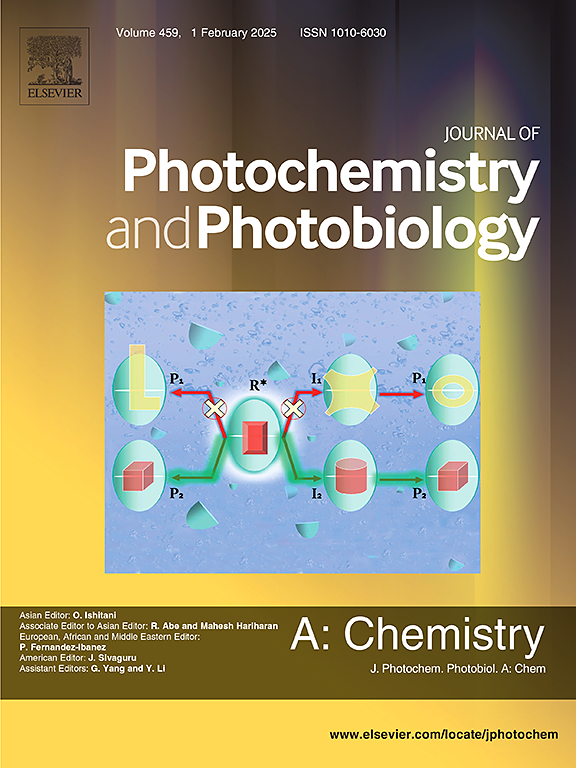CaCO3 modification of TiO2 electrodes in dye-sensitized solar cells: Enhanced of electron lifetime and efficiency
IF 4.1
3区 化学
Q2 CHEMISTRY, PHYSICAL
Journal of Photochemistry and Photobiology A-chemistry
Pub Date : 2025-04-05
DOI:10.1016/j.jphotochem.2025.116418
引用次数: 0
Abstract
Herein, we investigate the effects of CaCO3 coating on TiO2 photoanode electrodes for dye-sensitized solar cells (DSCs). TiO2 films are coated with varying thicknesses of CaCO3 using a spin-coating technique, and the resulting photoanodes are characterized for their structural, optical, and electrochemical properties. Field-emission scanning electron microscopy (FESEM) images reveal that the CaCO3 coating formed uniform nanocube structures, enhancing the surface morphology and scattering properties of the photoanode. X-ray diffraction (XRD) analysis confirms the presence of both anatase-TiO2 and calcite-CaCO3 phases, while optical measurements indicate a slight increase in the bandgap of the CaCO3-coated TiO2 films. Photovoltaic testing demonstrates that the optimal CaCO3 thickness (around 570 nm) significantly improved the power conversion efficiency (PCE) of DSSCs, achieving a maximum efficiency of 9.19 %, compared to 7.58 % for pristine TiO2. Electrochemical impedance spectroscopy (EIS) and open-circuit voltage decay (OCVD) measurements reveal that the CaCO3 coating reduced charge recombination, enhanced electron injection, and improved charge transport in the devices. Our results indicate that a thin CaCO3 layer effectively enhances the photovoltaic performance of TiO2-based DSCs by reducing electron recombination, improving dye adsorption, and enhancing electron injection, while thicker coatings can negatively affect device performance due to increased recombination and electron transport barriers. These findings provide valuable insights into the design of photoanodes for efficient DSCs, emphasizing the importance of optimizing the CaCO3 coating thickness.

CaCO3修饰染料敏化太阳能电池中TiO2电极:提高电子寿命和效率
在此,我们研究了CaCO3涂层对染料敏化太阳能电池(dsc)的TiO2光阳极电极的影响。利用自旋镀膜技术在TiO2薄膜上涂覆不同厚度的CaCO3,得到的光阳极具有结构、光学和电化学性能。场发射扫描电镜(FESEM)图像显示,CaCO3涂层形成了均匀的纳米立方体结构,增强了光阳极的表面形貌和散射性能。x射线衍射(XRD)分析证实了锐钛矿-TiO2和方解石- caco3相的存在,而光学测量表明caco3涂层的TiO2薄膜的带隙略有增加。光伏测试表明,最佳CaCO3厚度(约570 nm)显著提高了DSSCs的功率转换效率(PCE),达到9.19%的最大效率,而原始TiO2的效率为7.58%。电化学阻抗谱(EIS)和开路电压衰减(OCVD)测量表明,CaCO3涂层减少了器件中的电荷复合,增强了电子注入,改善了器件中的电荷输运。我们的研究结果表明,较薄的CaCO3层通过减少电子复合、改善染料吸附和增强电子注入,有效地提高了tio2基dsc的光伏性能,而较厚的涂层由于增加了复合和电子传递障碍,会对器件性能产生负面影响。这些发现为高效dsc光阳极的设计提供了有价值的见解,强调了优化CaCO3涂层厚度的重要性。
本文章由计算机程序翻译,如有差异,请以英文原文为准。
求助全文
约1分钟内获得全文
求助全文
来源期刊
CiteScore
7.90
自引率
7.00%
发文量
580
审稿时长
48 days
期刊介绍:
JPPA publishes the results of fundamental studies on all aspects of chemical phenomena induced by interactions between light and molecules/matter of all kinds.
All systems capable of being described at the molecular or integrated multimolecular level are appropriate for the journal. This includes all molecular chemical species as well as biomolecular, supramolecular, polymer and other macromolecular systems, as well as solid state photochemistry. In addition, the journal publishes studies of semiconductor and other photoactive organic and inorganic materials, photocatalysis (organic, inorganic, supramolecular and superconductor).
The scope includes condensed and gas phase photochemistry, as well as synchrotron radiation chemistry. A broad range of processes and techniques in photochemistry are covered such as light induced energy, electron and proton transfer; nonlinear photochemical behavior; mechanistic investigation of photochemical reactions and identification of the products of photochemical reactions; quantum yield determinations and measurements of rate constants for primary and secondary photochemical processes; steady-state and time-resolved emission, ultrafast spectroscopic methods, single molecule spectroscopy, time resolved X-ray diffraction, luminescence microscopy, and scattering spectroscopy applied to photochemistry. Papers in emerging and applied areas such as luminescent sensors, electroluminescence, solar energy conversion, atmospheric photochemistry, environmental remediation, and related photocatalytic chemistry are also welcome.

 求助内容:
求助内容: 应助结果提醒方式:
应助结果提醒方式:


